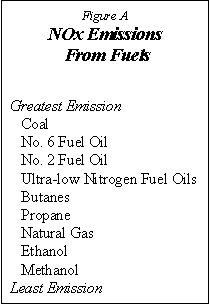Techniques for Reducing NOx Emissions from Industrial Boilers
More than 60,000 industrial boilers exist in the United States. In contrast to large utility boilers, industrial boilers have received little focus for NOx emission reductions. However, several alternatives to reduce NOx emissions currently are available, and others are under development.
Most NOx emissions are derived from nitrogen in the fuels used or from nitrogen in the combustion air (thermal NOx). For natural gas-fired and No. 2 oil-fired boilers, thermal NOx represents the majority of NOx produced from industrial boilers. Thermal NOx emissions increase with increasing peak flame temperatures and are affected by oxygen availability in the boiler combustion zone. Several measures to reduce NOx emissions in industrial boilers are listed in Table 1 and discussed below.
|
Table 1 |
|
|
NOx Reduction Technique |
Approximate NOx |
|---|---|
|
Tune-up and Burner System Modifications |
10-30% |
|
Burners Out of Service |
10-40% |
|
Boiler De-rating |
Up to 30% |
|
Low Excess Air |
10-25% |
|
Stage Combustion |
Up to 50+% |
|
Low NOx Burners |
40-60% |
|
Alternate Fuels |
Up to 50% |
Tune-up and Burner System Modifications. Any prudent NOx reduction measures should begin with a boiler tune-up to verify and optimize current boiler operating parameters. The fine-tuning of oxygen and fuel content in the combustion zone can improve efficiency and reduce NOx emissions. Beyond simple tune-ups, systems can be installed to automatically monitor and trim oxygen and fuels for peak performance. These procedures must be performed by a qualified individual because serious hazards can result if controls are applied inappropriately.
Burners Out of Service (BOOS). Boilers with multiple burners sometimes can use BOOS techniques to reduce NOx. By taking one or more burners out of service, peak flame temperature and the resulting NOx emissions are reduced by a number of combustion mechanisms.
Boiler De-rating. In some instances, when a facility’s steam demand has dropped because of phased-out equipment or the implementation of more energy efficient processes, a boiler can be de-rated to fire at lower loads. Under these circumstances, lowering the firing rate will effectively reduce NOx emissions.

Low Excess Air. For boilers that use ring or spud burners, several modifications can be made that control flame length, delay combustion, delay fuel/air mixing, and reduce peak flame temperature to reduce NOx. Sometimes air registers around the burner can be adjusted to also help reduce NOx.
Stage Combustion. Usually stage combustion can be achieved only in boilers with large furnace volumes. Stage combustion allows air and fuel to react in multiple zones or stages instead of at once. This process produces lower peak flame temperatures and other combustion properties favorable for low NOx emissions.
Low NOx Burners. Available for both new and retrofit applications, all low NOx burners use staged combustion techniques and can reduce NOx emissions 20 to 40 percent.
Alternate Fuels. Many facilities have modified their boilers to burn natural gas, which generates less NOx than fuel oils. Methanol and ethanol are other alternative fuels that can reduce NOx. Also, they may be used as back-up fuels during natural gas supply shortages. Figure A ranks the NOx emissions for several fuels.
When considering any measure to reduce boiler NOx emissions, follow these guidelines: 1) select a qualified consultant, vendor, or service provider, 2) conduct a boiler characterization, 3) perform the lowest-cost procedures first, 4) select appropriate NOx reduction measures, 5) implement measures, 6) retest boiler, and 7) continue proper operation and maintenance.